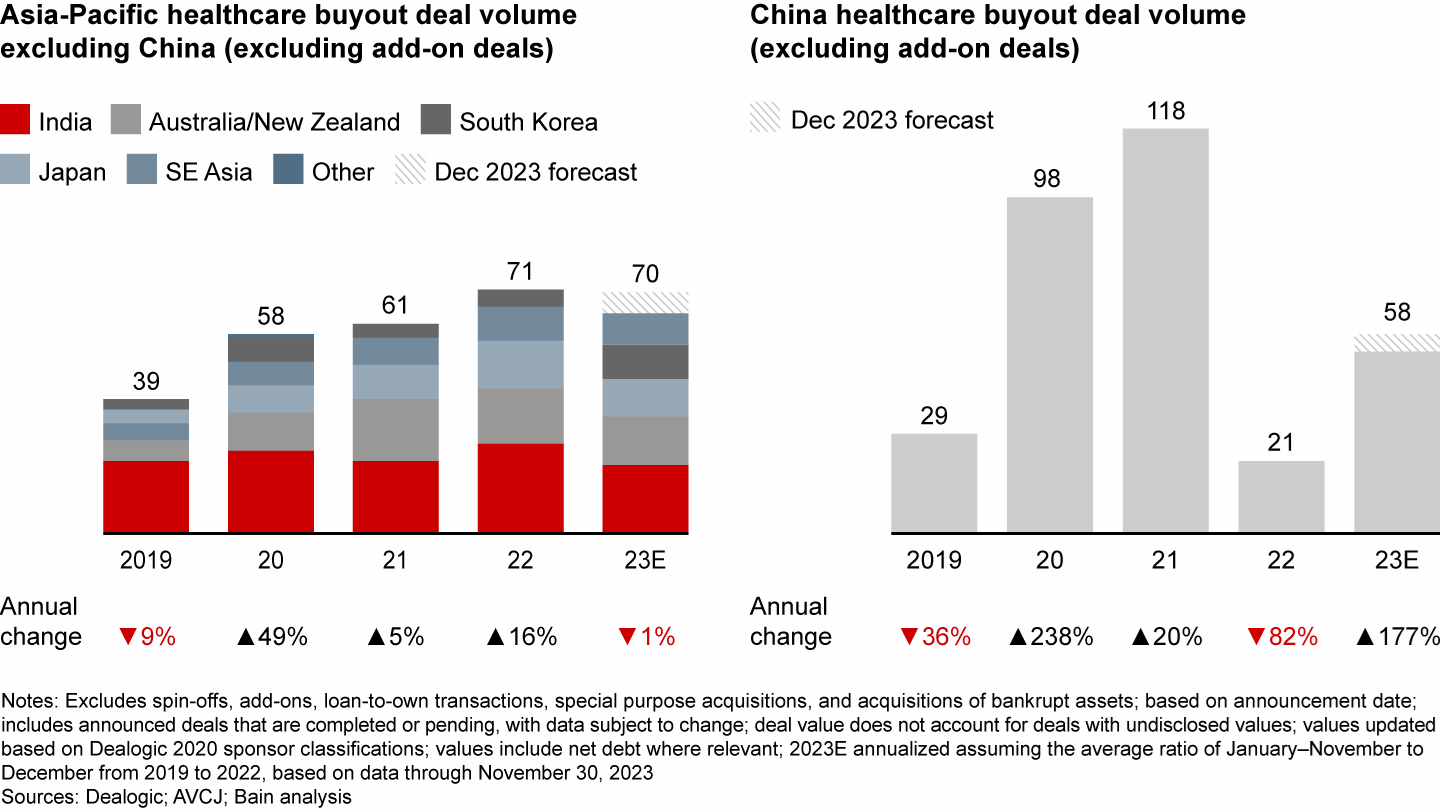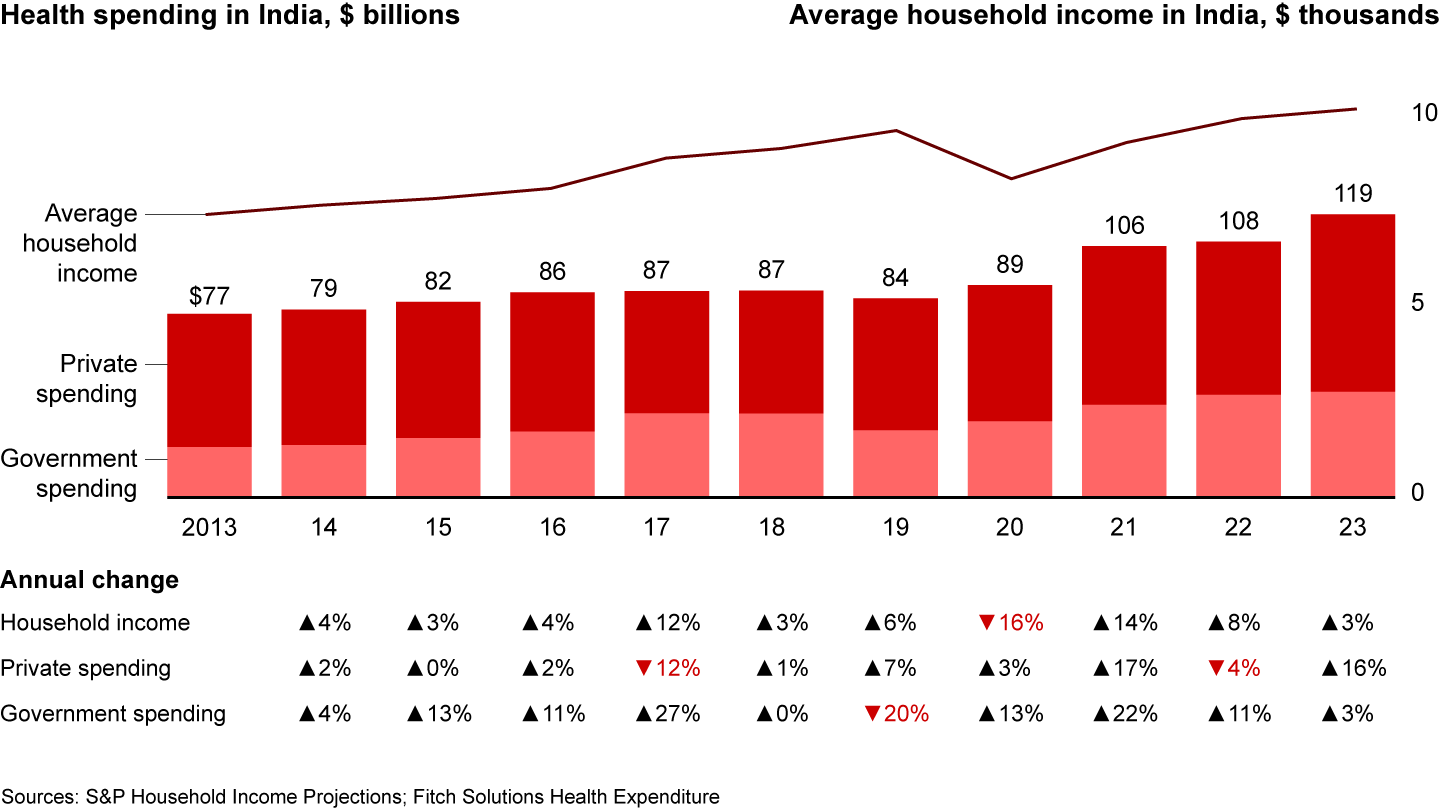Global Healthcare Private Equity Report

At a Glance
- Private equity deal volume in Asia-Pacific remained robust in 2023, bucking the slowdown seen in North America.
- Investors are looking to diversify their geographic presence within Asia-Pacific, which is now experiencing multiple engines of growth.
- India’s economic growth, business-friendly government, pharmaceuticals manufacturing landscape, and thriving middle class are driving investment.
- Spending on private healthcare, growing pharma manufacturing and services, and an evolving healthcare technology ecosystem are turning India into a private equity hub.
Este artigo faz parte do Relatório de Fusões e Aquisições de 2023 da Bain.
Healthcare markets in the Asia-Pacific region are maturing—and in parallel, private equity (PE) deal volume is bucking the slowdown seen in North America (see Figure 1). Asia-Pacific’s share of global healthcare PE deals continues to rise, growing from 26% of global deal activity in 2022 to a projected 34% in 2023.
Asia-Pacific bucked the deal slowdown found in North America in 2023


The Asia-Pacific region has seen intensified deal activity outside of China—historically the main engine of transactions in the area—and is being transformed into a region with multiple engines of growth. Buyouts increasingly occurred across the geography, from the high-income economies like Australia and South Korea to budding middle-income nations such as India. About two-thirds of the deals in India were executed by funds with less than $50 billion in assets under management (AUM), illustrating the wealth of activity outside of megacap funds.
In China, many investors have stayed on the sidelines as the country navigates an evolving healthcare policy, Covid’s impact on public budgets, and a softening economy. Nonetheless, Chinese activity has begun to rebound, rising from 21 deals in 2022 for a total of $1.6 billion in value, to a projected 58 deals in 2023, reaching around $3.4 billion in value (see Figure 2). Overall, Asia-Pacific buyout activity declined, from $17.1 billion in 2022 to $14.2 billion in 2023, though it held up well compared with other regions.
China’s rebound in deal volume during 2023 largely accounts for the overall rise in volume in Asia-Pacific


Many biopharma and medtech companies have shifted toward a “China plus one” strategy: diversifying beyond China and creating opportunity for input and final product manufacturers in countries with deep talent pools, low labor costs, and business-friendly environments. Moreover, private spending on healthcare is on the rise across Asia-Pacific, as economic growth lifts millions of people into the middle class and health takes on new importance in the wake of the pandemic.
India stands out as the main force expanding Asia-Pacific’s share of global deal activity, accounting for roughly 30% of the region’s deal value from 2022 to 2023 (see Figure 3). Resilient economic growth, a business-friendly government, a maturing pharmaceutical manufacturing landscape, and a burgeoning middle class eager to pay for quality healthcare have resulted in many investment opportunities. In 2023, India is expected to host 22 healthcare deals, a slight decline from the 26 in 2022. Deal value is expected to come in at $4.6 billion in 2023, just below the $4.7 billion in 2022, with India remaining the leader in deal value across the region.
India leads the Asia-Pacific region in deal value


Importantly, exits for investors in India have been strong, validating the country’s significant upside potential. Deal selection was still critical to generate returns during this period, as demonstrated by notable exits such as TPG’s 2023 sale of a controlling stake in Care Hospitals to Blackstone. Global PE investors have grown more comfortable putting larger amounts of capital to work in India, making the market more competitive. Moreover, more transactions are becoming controlling deals, as the perceived risk of making large investments in India diminishes—including for owners, who are often founders of the healthcare asset, and who are becoming more comfortable handing over the reins to investors.
Three forces behind India’s rise
India’s rise as a new hub of healthcare PE deal activity stems from three factors: greater expenditure on private and public healthcare, booming pharma manufacturing and services, and an evolving healthcare technology ecosystem.
Spending on private and public healthcare: India’s fast-growing middle class is spending more on healthcare. With disposable incomes rising and an explosion of insurance technology (insurtech) platforms and private payers (such as Digit and Acko), private healthcare has become more accessible. Moreover, Covid served to reset consumers’ attitudes about their own spending on healthcare, as a large share of the population personally witnessed Covid-related tragedies, shoring up the importance of health in their minds. Meanwhile, government health expenditures have risen significantly over the past decade (from around 29% of total health expenditure in 2014–15 to approximately 39% in 2021–22—S&P Global data), and healthcare spending is expected to grow further (see Figure 4).
Private and public spending on healthcare have been rising in India


Demand for high-quality healthcare has been met with supply as more investors enter the market. Multi-specialty hospitals have seen a flurry of activity over the past decade, including deals in 2023, such as Temasek’s acquisition of an additional 41% of Manipal Health Enterprises (bringing its ownership to 59%) for around $2 billion, and Blackstone’s acquiring a controlling stake in Care Hospitals for some $800 million from TPG. More recently, single-specialty clinics have seen a surge in activity, most notably with BPEA EQT’s acquisition of a controlling stake in Indira IVF, an in vitro fertilization clinic chain, valued at $1.1 billion.
Booming pharma manufacturing and services: India’s stature in small molecule manufacturing has risen. Supportive government policy (including the Production Linkage Incentive program), a vast pool of chemistry and engineering talent, a strengthening pharma ecosystem, and a push to diversify supply chains from China have propelled India’s rise to a top-3 global manufacturer of pharmaceuticals by volume, and the top global generics manufacturer. Covid further boosted India to the top position in vaccine manufacturing, supplying 50% of global vaccine demand.
For PE investors, India’s emergence as a leading pharma hub has created an opportunity in pharma services, especially manufacturing services, such as contract development and manufacturing organizations (CDMOs) and active pharmaceutical ingredient (API) producers. Global PE funds—including Advent International under its Cohance Lifesciences brand, Carlyle via drugmaker Viyash, and PAG via Sekhmet Pharmaventures—continued to grow their API/CDMO platforms started in 2021–22 with a number of add-ons.
While small molecules have been the focus to date, there are early signs that large molecules, especially biologics, may be the next frontier as many such therapies start to go off patent, creating opportunity for generics. But China may have the leg up in generics, given its deeper talent pools in key areas of expertise such as microbiology.
Evolving healthcare technology ecosystem: India has historically served as the back end for many US- and Europe-focused healthcare data and analytics companies, such as revenue cycle outsourcers. However, in recent years, digital health companies serving the Indian market directly—especially in fitness and wellness, such as HealthifyMe, telemedicine, such as Mfine, and insurtech, including Turtlemint and Even—have seen brisk activity. While dealmaking in digital health has slowed, long-term fundamentals, notably a young population eager to engage digitally, remain strong for Indian companies operating at the intersection of healthcare and technology.
Investors vie over opportunities
India’s share of global deal activity remains on an upward trajectory. Private providers (both multispecialty and single specialty) present significant long-term opportunity, given the fragmentation and underpenetration in healthcare currently. Investors that can scale up to deliver high-quality care that meets the surging demand in the Indian market have the potential to replicate the generous returns seen in recent years. Similarly, pharma manufacturing will continue to present opportunity for private equity, given the sector’s fragmentation, supportive government policies, and potential in biologics and generics.
The past few years have proved that the risk-return profile of investing in healthcare in India is very favorable: For relatively small incremental risk above higher-income markets, the potential for strong return is significant.
Este artigo faz parte do Relatório de Fusões e Aquisições de 2023 da Bain.